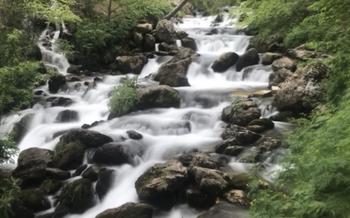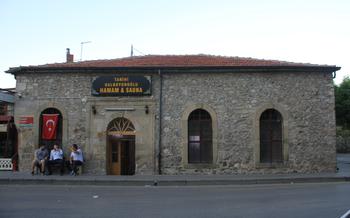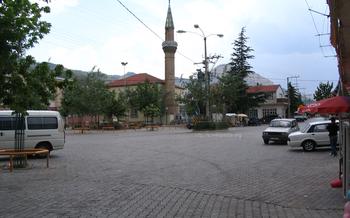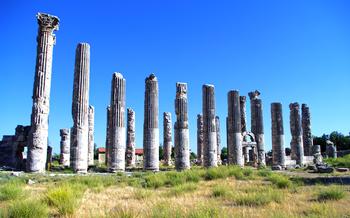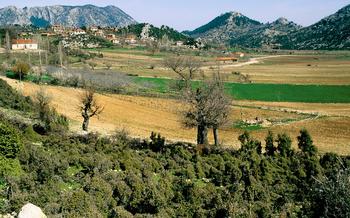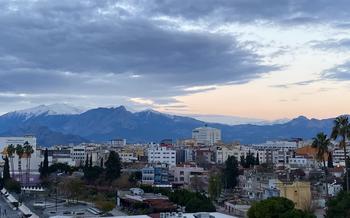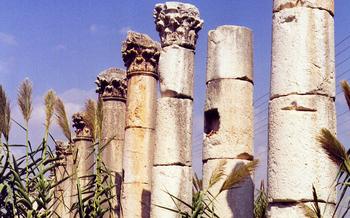
Kremna Ancient City
- The Antiquity of Kremna
- Location and Accessibility
- Proximity to Other Historical Sites and Natural Attractions
- Architectural Marvels
- Religious Significance
- Historical Figures
- Legends and Myths:
- Daily Life in Kremna
- Restoration and Conservation Efforts
- The Natural Beauty of Kremna
- Tips for Visiting Kremna:
- Guided Tours and Local Guides
- Accommodation and Dining Options
- Combining with Other Attractions
- Insider Tip: Unveiling the Hidden Gem of Kremna's Theater
The Antiquity of Kremna
Kremna, an ancient city nestled in the heart of Turkey's Isparta province, boasts a rich history dating back to the Hellenistic period. Founded in the 3rd century BC, it flourished under the influence of various civilizations, leaving behind a legacy of architectural marvels and cultural significance. Excavations at the site have unearthed impressive ruins, including temples, theaters, and public buildings, shedding light on the city's urban planning and engineering prowess. Well-preserved mosaics, friezes, and sculptures further enhance our understanding of Kremna's artistic heritage, offering glimpses into the daily lives and beliefs of its ancient inhabitants.
Location and Accessibility
Kremna's rich history and cultural significance are intertwined with its strategic location in the Isparta province of Turkey. Situated amidst the picturesque Taurus Mountains and fertile plains, the ancient city offers easy accessibility for travelers seeking to delve into its wonders.
To reach Kremna, visitors can embark on a scenic journey by road, following well-maintained highways that lead to the site. The city's proximity to Isparta, the provincial capital, makes it a convenient destination for day trips or extended explorations.
Proximity to Other Historical Sites and Natural Attractions
Kremna's allure extends beyond its own boundaries, as it is surrounded by a wealth of historical sites and natural attractions. A short drive away lies the ancient city of Sagalassos, renowned for its remarkably preserved ruins and stunning mountain backdrop.
Nature enthusiasts can venture into the nearby national parks, such as the Kremna National Park, which offers breathtaking hiking trails, cascading waterfalls, and diverse flora and fauna. The region's unique geological formations, including the spectacular Eğirdir Lake, add to the area's natural charm.
Combining a visit to Kremna with explorations of these surrounding gems creates a comprehensive and unforgettable travel experience, allowing visitors to immerse themselves in the region's rich cultural heritage and natural beauty.
Architectural Marvels
Kremna's architectural legacy stands as a testament to the city's grandeur and engineering prowess. Among the most impressive ruins are the remains of the Temple of Zeus, once a majestic structure that dominated the city's skyline. Its towering columns and intricate carvings hint at the religious fervor that permeated Kremna's society.
Equally captivating is the well-preserved theater, a testament to the city's love for the arts. With its tiered seating and impressive acoustics, it's easy to imagine the vibrant performances that once graced its stage. The theater's backdrop, adorned with intricate reliefs depicting mythological scenes, transports visitors back in time.
Kremna's urban planning and engineering skills are evident throughout the city. The well-preserved streets, lined with shops and public buildings, showcase sophisticated drainage systems and architectural techniques that were ahead of their time. The city's water supply system, with its intricate network of aqueducts and cisterns, ensured a reliable water source for the city's inhabitants.
Religious Significance
The ancient city of Kremna was deeply influenced by religion, with temples dedicated to various deities playing a central role in the lives of its inhabitants. The most prominent temple in Kremna was dedicated to Zeus, the king of the gods in Greek mythology. The temple was a grand structure that showcased impressive architecture and intricate carvings. It served as a place of worship, rituals, and religious ceremonies for the citizens of Kremna.
In addition to the temple of Zeus, there were several other temples dedicated to deities such as Dionysus, the god of wine and celebration; Apollon, the god of prophecy and healing; and Artemis, the goddess of hunting and nature. These temples were not only places of worship but also served as community centers where people gathered for religious festivals, social events, and to seek guidance from the gods.
Archaeological excavations at Kremna have revealed numerous artifacts and inscriptions that shed light on the religious practices of the ancient city's inhabitants. These discoveries include votive offerings, such as statues, pottery, and coins, which were dedicated to the gods as a form of gratitude or to seek their favor. The presence of these artifacts and inscriptions provides valuable insights into the religious beliefs and rituals that shaped the daily lives of the people of Kremna.
Historical Figures
Kremna, with its rich history, has been associated with several notable individuals. Pisidicus, a renowned poet and philosopher, hailed from Kremna and left an enduring legacy through his writings. Oreste, a legendary figure from Greek mythology, is said to have visited the city during his travels. The ancient city was also home to Diomedes, a brave warrior who fought in the Trojan War. These individuals have left an indelible mark on Kremna's history and culture, contributing to its reputation as a vibrant center of intellectual and artistic pursuits.
One intriguing anecdote involves Emperor Hadrian, who visited Kremna during his reign. Impressed by the city's beauty and grandeur, he ordered the construction of a grand temple dedicated to Zeus. This temple, known as the "Hadrianic Temple," became a testament to the emperor's admiration for Kremna and further enhanced its reputation as a city of cultural significance.
Legends and Myths:
Kremna is steeped in a rich tapestry of legends and myths that have shaped its cultural identity. One captivating tale revolves around its foundation. According to local folklore, the city was established by a group of adventurous shepherds who stumbled upon a hidden cave filled with shimmering gold and precious jewels. Inspired by divine signs, they decided to settle in the area and built the city of Kremna, using the discovered treasures to construct magnificent temples and palaces.
Daily Life in Kremna
The inhabitants of Kremna led vibrant and diverse lives, engaging in various economic activities, social customs, and forms of entertainment. Agriculture played a significant role in the city's economy, with farmers cultivating crops such as wheat, barley, and grapes. Additionally, animal husbandry was practiced, with sheep, goats, and cattle being raised for their wool, milk, and meat. Trade and commerce flourished in Kremna, with merchants exchanging goods from distant lands. The city's strategic location along trade routes facilitated the flow of goods and ideas.
Social customs in Kremna were influenced by both Hellenistic and Roman traditions. Family bonds were strong, and the community placed great importance on hospitality and respect for elders. Education was valued, and there were schools where children learned reading, writing, and mathematics. The city's inhabitants celebrated various festivals and religious holidays throughout the year, providing opportunities for social gatherings and entertainment.
Kremna's residents enjoyed a variety of leisure activities. Public baths were popular places for relaxation and socializing, and there were also theaters where plays and musical performances were held. The city's gymnasium, dedicated to physical fitness and education, offered facilities for sports such as wrestling, running, and javelin throwing. In the surrounding countryside, people could engage in hunting, fishing, and nature walks.
Restoration and Conservation Efforts
Kremna, with its wealth of historical treasures, has garnered significant attention from archaeologists, historians, and preservationists. Recognizing the urgent need to protect and restore this ancient city, several restoration and conservation initiatives have been undertaken. These projects aim to preserve the integrity of Kremna's ruins while ensuring their accessibility to future generations.
One of the key challenges in preserving Kremna lies in the sheer size of the site. Spanning over 100 hectares, the ancient city presents a vast canvas for restoration work. Archaeologists and conservators have meticulously documented and mapped the site, prioritizing areas that require immediate attention.
Efforts have focused on stabilizing and reinforcing the remaining structures, including the theater, temples, and public buildings. Careful attention has been paid to preserving the original materials and techniques used in their construction. This delicate work involves shoring up walls, repairing damaged columns, and restoring intricate carvings.
In addition to structural restoration, conservationists have also undertaken extensive cleaning and documentation of the site's many artifacts. Mosaics, sculptures, and inscriptions have been meticulously cleaned and cataloged, providing valuable insights into Kremna's rich artistic and cultural heritage.
The restoration and conservation efforts at Kremna are a testament to the enduring significance of this ancient city. By preserving its ruins and artifacts, these projects ensure that future generations can continue to appreciate and learn from this remarkable site.
The Natural Beauty of Kremna
In addition to its historical significance, Kremna is nestled amidst a breathtaking natural setting that enhances its charm and provides a unique backdrop for exploration. Surrounded by picturesque mountains, lush forests, and rolling hills, the ancient city blends seamlessly with its natural surroundings, creating a harmonious union of history and nature.
The integration of natural elements into Kremna's architecture and urban design is evident throughout the site. Many buildings feature courtyards adorned with trees and gardens, providing shade and a serene atmosphere. The city's streets and public spaces were carefully planned to incorporate natural elements, such as water fountains and decorative pools, which added both aesthetic value and a refreshing ambiance.
For those who appreciate the outdoors, Kremna offers a variety of hiking and nature trails that wind through the surrounding countryside. These trails provide an opportunity to explore the region's diverse flora and fauna, enjoy panoramic views of the ancient city and the surrounding landscapes, and immerse oneself in the tranquility of nature.
Whether you're a history buff, nature enthusiast, or simply seeking a unique and inspiring destination, Kremna's natural beauty is sure to leave a lasting impression. Embark on a journey through time and nature as you discover the hidden treasures of this remarkable ancient city.
Tips for Visiting Kremna:
Planning a visit to Kremna is an enriching experience, but it requires some preparation to make the most of your time. Here are some practical tips to ensure a smooth and enjoyable visit:
-
Best Time to Visit: The ideal time to visit Kremna is during the shoulder seasons, namely spring (April-May) and autumn (September-October). These months offer pleasant weather, fewer crowds, and stunning natural scenery.
-
Essential Items: Pack comfortable shoes for walking on uneven terrain, a hat or sunglasses for sun protection, and a refillable water bottle to stay hydrated. Sunscreen and insect repellent are also recommended.
-
Guided Tours: Enhance your visit by booking a guided tour with a knowledgeable local guide. They can provide historical insights, point out hidden details, and answer your questions. Group tours and private tours are available.
-
Duration of Visit: Allocate at least half a day to explore the ruins of Kremna. This will give you enough time to see the main attractions, walk around the site, and take photographs. If you have more time, consider spending a full day to delve deeper into the history and culture of the ancient city.
-
Photography Enthusiasts: Bring your camera to capture the beauty of Kremna's ruins and the surrounding natural landscapes. The golden hour (sunrise and sunset) offers stunning lighting conditions for photography.
-
Respect the Site: Remember that Kremna is an archaeological site, and it is important to be respectful of the ruins and artifacts. Please do not climb on the structures or remove any objects from the site.
Guided Tours and Local Guides
Kremna, with its rich history and well-preserved ruins, is best explored with the guidance of knowledgeable local experts. Guided tours are available in various languages, providing visitors with in-depth insights into the ancient city's architecture, history, and significance. These tours typically cover the major landmarks, such as the theater, temples, and agora, while also shedding light on the daily lives and customs of Kremna's inhabitants.
Booking a guided tour ensures that you make the most of your visit, as experienced guides can provide valuable context and historical information that would otherwise be missed. They can point out hidden details, explain the significance of various artifacts, and answer any questions you may have. Local guides often have a deep connection to the region and can share personal anecdotes and stories that bring the ancient city to life.
When choosing a tour operator, it's essential to do your research and read reviews from previous travelers. Look for reputable companies that employ certified guides with a passion for history and archaeology. Consider the group size, as smaller groups often provide a more personalized experience.
Guided tours typically depart from Isparta or nearby towns and can range from half-day to full-day excursions. Prices vary depending on the duration and inclusions, so it's a good idea to compare options and choose one that fits your budget and interests.
Accommodation and Dining Options
When planning your visit to Kremna, you'll find a range of accommodation options to suit your needs and preferences. For a comfortable and convenient stay, consider booking a room at one of the nearby hotels or guesthouses. These establishments offer a variety of amenities, including cozy rooms, delicious breakfast options, and helpful staff who can assist you with any inquiries or arrangements.
To immerse yourself in the local culture, I highly recommend trying out the traditional Turkish cuisine at the restaurants and cafes in the area. Savor the flavors of delectable dishes such as kebabs, gözleme, and Turkish delight. Don't miss the opportunity to indulge in the region's culinary delights, which are sure to tantalize your taste buds and leave you wanting more.
Combining with Other Attractions
Kremna's allure extends beyond its own boundaries, inviting you to explore a tapestry of historical and natural wonders that dot the region. Just a short drive away, the ancient city of Sagalassos awaits with its impressive ruins and stunning location amidst the Taurus Mountains. Step into the past as you marvel at the well-preserved theater, agora, and intricate mosaics that tell tales of a bygone era.
Venture further to discover the breathtaking natural beauty of Lake Kovada, a serene haven nestled amidst lush forests and towering peaks. Embark on a scenic hike along its shores, taking in the tranquility of the surroundings and capturing picturesque moments. For a unique perspective, embark on a boat tour that offers panoramic views of the lake and the surrounding landscapes.
Enhance your journey by visiting the nearby town of Eğirdir, steeped in history and charm. Stroll through its narrow cobblestone streets, where traditional Turkish houses line the way, and soak in the vibrant atmosphere of the local markets. Don't miss the opportunity to savor the delectable flavors of Eğirdir's renowned kuyu kebabı, a slow-cooked lamb dish that tantalizes the taste buds.
Create a comprehensive itinerary that allows you to delve into the rich cultural heritage and natural beauty of the region. Whether you choose to embark on day trips or extend your stay for a multi-day adventure, the possibilities are endless. Discover the hidden gems that lie just beyond Kremna's ancient walls and create memories that will last a lifetime.
Insider Tip: Unveiling the Hidden Gem of Kremna's Theater
Amidst the ruins of Kremna, there lies a hidden gem that often goes unnoticed by visitors: the ancient theater. While not as grand as some of the other structures in the city, this theater holds a special charm that transports you back in time.
As you enter the theater, let your imagination run wild as you envision the lively performances that once took place here. The acoustics are remarkably well-preserved, and if you're lucky, you might catch a local musician or performer using the space for impromptu concerts or recitals.
The theater's location is also unique. Nestled into the hillside, it offers breathtaking views of the surrounding mountains and forests. During sunset, the sky transforms into a canvas of vibrant colors, creating a magical backdrop for your visit.
Whether you're a history buff, a theater enthusiast, or simply someone who appreciates hidden gems, make sure to add Kremna's theater to your itinerary. It's a place where you can experience the essence of this ancient city in a truly special way.
